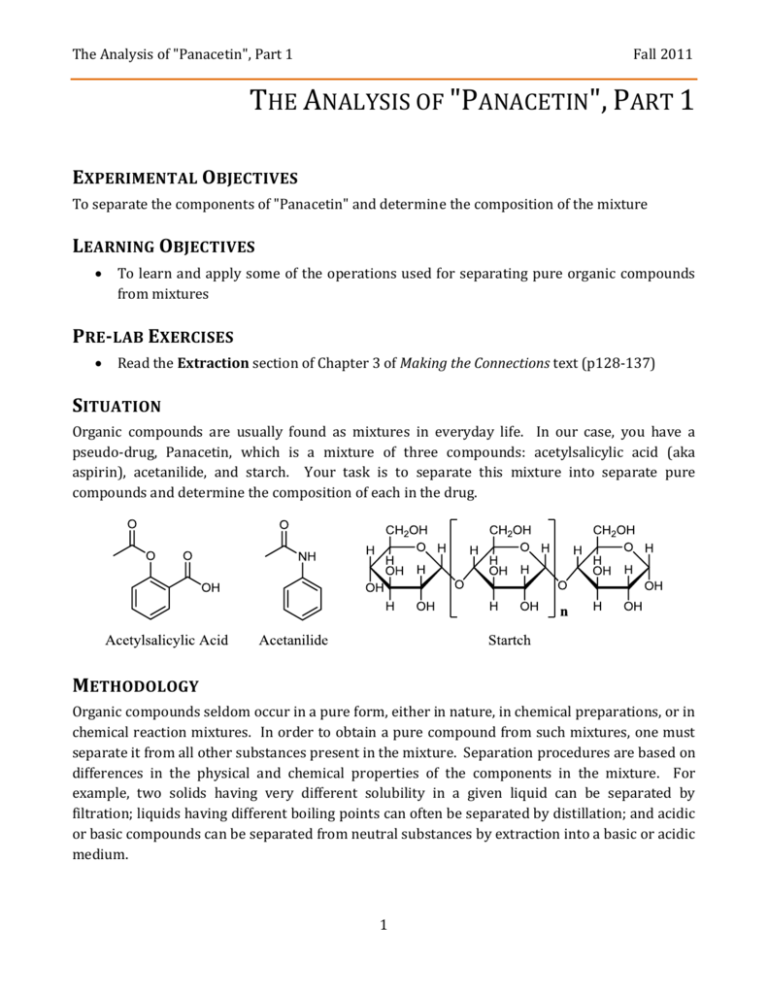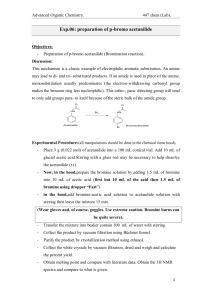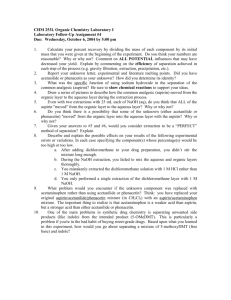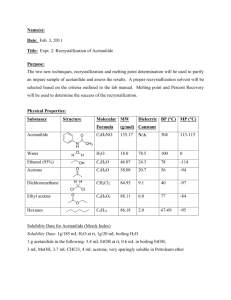The Analysis of "Panacetin", Part 1
advertisement

The Analysis of "Panacetin", Part 1 Fall 2011 THE ANALYSIS OF "PANACETIN", PART 1 EXPERIMENTAL OBJECTIVES To separate the components of "Panacetin" and determine the composition of the mixture LEARNING OBJECTIVES To learn and apply some of the operations used for separating pure organic compounds from mixtures PRE-LAB EXERCISES Read the Extraction section of Chapter 3 of Making the Connections text (p128-137) SITUATION Organic compounds are usually found as mixtures in everyday life. In our case, you have a pseudo-drug, Panacetin, which is a mixture of three compounds: acetylsalicylic acid (aka aspirin), acetanilide, and starch. Your task is to separate this mixture into separate pure compounds and determine the composition of each in the drug. METHODOLOGY Organic compounds seldom occur in a pure form, either in nature, in chemical preparations, or in chemical reaction mixtures. In order to obtain a pure compound from such mixtures, one must separate it from all other substances present in the mixture. Separation procedures are based on differences in the physical and chemical properties of the components in the mixture. For example, two solids having very different solubility in a given liquid can be separated by filtration; liquids having different boiling points can often be separated by distillation; and acidic or basic compounds can be separated from neutral substances by extraction into a basic or acidic medium. 1 The Analysis of "Panacetin", Part 1 Fall 2011 Of the three components likely to be present in your sample of Panacetin (aspirin, acetanilide, and starch), only starch is insoluble in the organic solvent dichloromethane (or methylene chloride), CH2Cl2. If a sample of Panacetin is dissolved as completely as possible in dichloromethane, the insoluble starch can be filtered out, leaving acetanilide and aspirin in solution. Although the acetanilide and aspirin are both quite insoluble in water at room temperature, the sodium salt of aspirin is very soluble in water but insoluble in dichloromethane. Because aspirin is a reasonably strong acid, it can be converted to the salt, sodium acetylsalicylate, by reaction with the basic sodium hydroxide. When a dilute aqueous solution of sodium hydroxide is added to the organic solution, two sharply separated layers result. The dichloromethane layer, being more dense and insoluble in water, will be on the bottom. If the two layers are thoroughly mixed, the aspirin will react with the sodium hydroxide in the bottom layer and be converted to sodium acetylsalicylate, which then migrates to the aqueous layer and can be easily separated in a separatory funnel. Adding some dilute hydrochloric acid to the aqueous solution regenerates free aspirin as an insoluble white solid; evaporating the solvent from the bottom layer leaves the acetanilide behind. Interconversion of Aspirin and its sodium salt PROCEDURE Weigh approximately 4.0 g of Panacetin to the nearest 0.01 g and transfer it to an Erlenmeyer flask. Measure 75 mL of CH2Cl2 into a graduated cylinder, add it to the solid, and stir the mixture vigorously using a flat bottomed stirring rod to break up any lumps. When it appears that no more of the solid will dissolve, you should filter the mixture by gravity, collect the undissolved solid on the filter paper, and set it aside to dry. It is advisable to weigh the filter paper beforehand, so that the weight of the starch can be obtained without transfer. Transfer the filtrate to a separatory funnel and extract it with two 25 mL portions of aqueous 1M sodium hydroxide. Drain the organic layer into a pre-weighed Erlenmeyer flask and save it for recovery of acetanilide. Take the combined aqueous extracts in an Erlenmeyer flask, and acidify the aqueous solution by slow addition, with stirring, of 20 mL of 3 M hydrochloric acid. Make sure the solution is strongly acidic by testing it with litmus paper. Cool the mixture to room temperature or below by swirling the flask occasionally in an ice bath. Collect the aspirin by vacuum filtration. Wash the aspirin on the filter with cold distilled water. Dry your sample 2 The Analysis of "Panacetin", Part 1 Fall 2011 thoroughly before weighing (let it sit in your drawer in the Buchner funnel until the following week). Evaporate the solvent from the CH2Cl2 solution in a warm water bath (the water does not need to boil – just warm enough to make the methylene chloride boil) to obtain the acetanilide. Get a rough mass of your impure acetanilide sample by reweighing your tared flask. Leave your sample in the flask for recrystallization in the next experiment. When each of the compounds (starch, aspirin) is completely dry, transfer them to tared (preweighed) vials (not viles) and weigh them to the nearest 0.01 g. Note that your acetanilide will be used in subsequent experiments (recrystallized next week). Eventually, you will turn in your samples to your instructor as instructed. Make sure your vials are labeled. The labels should include your name, the date, name of the contents, and additional data as requested by the instructor. 3 The Analysis of “Panacetin”, Part 2 Fall 2011 THE ANALYSIS OF "PANACETIN", PART 2 EXPERIMENTAL OBJECTIVES To purify the acetanilide isolated in Experiment 1, verify its identity, and assess its purity. LEARNING OBJECTIVES To learn how to purify solids by recrystallization, how to dry them, and how to obtain a melting point. To learn and understand some basic concepts relating to the purification and analysis of organic compounds. METHODOLOGY A compound that has been separated from a mixture is seldom ready for immediate analysis or for applications requiring a pure substance. Contamination may result from a variety of sources: 1. The separation procedure may be imperfect, leaving small quantities of other substances in the compound after separation. 2. Additional contaminants may be introduced during the separation, either accidentally or as an inevitable consequence of the separation procedure used. 3. Chemical reactions may occur prior to or during the separation, adding new impurities. Purification of the compound is thus necessary. Chapter 3 of the Making the Connections text is devoted to the many different purification techniques available for use in the organic chemistry laboratory. This lab will utilize recrystallization. PRE-LAB EXERCISES 1. Read Melting Point for Solids in Chapter 2 of Making the Connections text (p47-53) 2. Read Recrystallization in Chapter 3 of Making the Connections text (p119-127) 3. The solubility of acetanilide in hot water (80 oC) is reported to be 3.5 g/100. Calculate the volume of hot water that should just dissolve all of the acetanilide you recovered from Experiment 1. PROCEDURE Purify the crude solid saved from the previous experiment Panacetin1 by recrystallizing it from boiling distilled water. Begin by heating your acetanilide with about half the amount of water calculated in the Pre-lab exercises. Add more hot water if necessary, until all of the solid is in solution. Use your vacuum filter to isolate your sample, and dry the purified crystals. 1 The Analysis of “Panacetin”, Part 2 Fall 2011 Obtain melting points of the dry crystals, of an authentic sample of acetanilide, and of a 1:1 mixture of the dry crystals with the authentic sample. The melting point of the authentic sample can be obtained while the crystals are drying. Each melting point should be measured on two samples-more than that if additional practice seems desirable or if the melting points are imprecise or inaccurate. Weigh the purified crystals in a tared (pre-weighed) vial. Once you have acquired all the data necessary from your compounds, turn them in as directed by your instructor. 2



